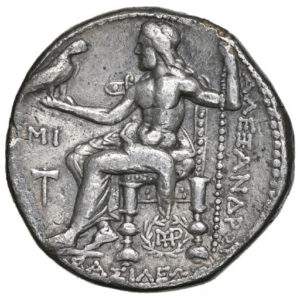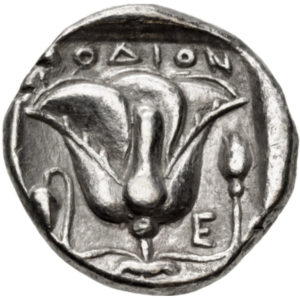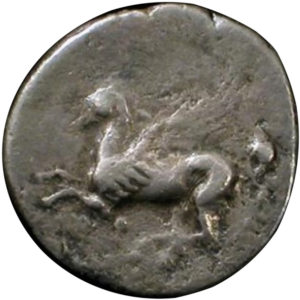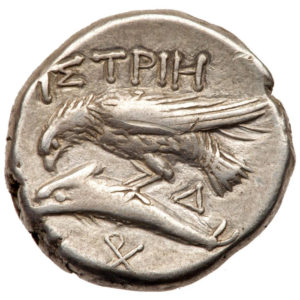Circa 100-70 BC – Islands off TROAS – Tenedos Tetradrachm
ISLANDS off TROAS, Tenedos. Circa 100-70 BC. AR Tetradrachm (37.5mm, 15.44 g, 12h). Janiform head of a bearded male left, laureate, and female right, wearing stephanos / Labrys; TENEΔIΩN above, cornucopia and grape bunch on vine flanking handle; all within wreath. Callataÿ, Tenedos -; HGC 6, 390; Triton VII, lot 227 (same obv. die). Toned, light roughness and porosity. Good VF. Very rare.
Tenedos was an island of strategic importance throughout antiquity due to its location at the entrance to the Hellespont, which ensured every ship sailing to or from the Propontis and the Black Sea would pass by. It is referenced in both Homer’s Iliad and Virgil’s Aeneid, in the latter as the place where the Greek fleet was concealed towards the end of their siege of Troy in order to trick the Trojans into taking the fateful Trojan horse within the walls of the city. During the fifth century, Athens used the island as a stronghold to protect their vital shipping routes, but it came under the influence of successive Hellenistic dynasties from the third century onwards: controlled first by the Seleukids, then the Attalids and eventually by Mithridates VI Eupator, who used the island as a naval base in the Third Mithridatic War against the Roman general Lucullus in 73-63 BC. It was during the latter’s long reign that this type and other stephanophoric (wreath-bearing) Tenedian tetradrachms were first minted.
The form of the exquisitely detailed janiform head, the proportions and intricate hairstyles of which are finely balanced, is satisfyingly echoed by the symmetrical reverse displaying the labrys, a double-headed axe, with a cornucopia and grape bunch under the axe. This labrys is a reference to the Tenedian foundational myth, in which the hero Tenes used an axe to sever the mooring lines of his father’s ship when he attempted to land on the island to reconcile with his son. In Pausanias’ version of the myth, he concludes “for this reason a by-word has arisen, which is used of those who make a stern refusal: so and so has cut whatever it may be with an axe of Tenedos” (Paus. 10.14.4). Indeed, Cicero, writing less than half a century from the time of this coin’s issue jokes to his brother Quintus about Tenedos’ unsuccessful request to the Roman senate to be made a free city: “well then, the liberty of the Tenedians has been chopped by the Tenedian axe” (Letters to his brother Quintus, 2.9).
The coinage of Tenedos (modern day Bozcaada in Turkey) is extremely rare and fascinating. The story of how Tenedos came into existence is one of mythology going back to Homer’s Iliad. The story goes that King Cycnos, a son of Apollo, had two children, a boy, Tenes and a daughter, Hemithea with his first wife. After the wife died, Cycnos married his second wife, Philonome, who made advances on Tenes, but was rebuked. Out of anger and to punish Tenes, Philonome told Cycnos that Tenes had raped her. She also got the flutist Eumolpus to substantiate her lie. Cycnos reacted savagely and attempting to kill his son and daughter, put them in a chest, which was set in the sea. The chest eventually sailed ashore to an island, Leucophrye, with the two still living, and the island was renamed Tenedos, in Tenes name. When Cycnos found out his children had survived and what had actually happened, he killed Eumolpus, buried Philonome alive and attempted to sail to Tenedos to his children. The earlier rejection of his father was too great however for Tenes and once Cycnos arrived at the island on ship and attempted to secure his vessel, Tenes drew his axe and cut the moorings.
It has been suggested that the male and female on the obverse of this coin would be Tenes and Hemithea, which certainly lends itself to the mythological history of the island. The reverse depicting the axe that Tenes used to sever the moorings.














